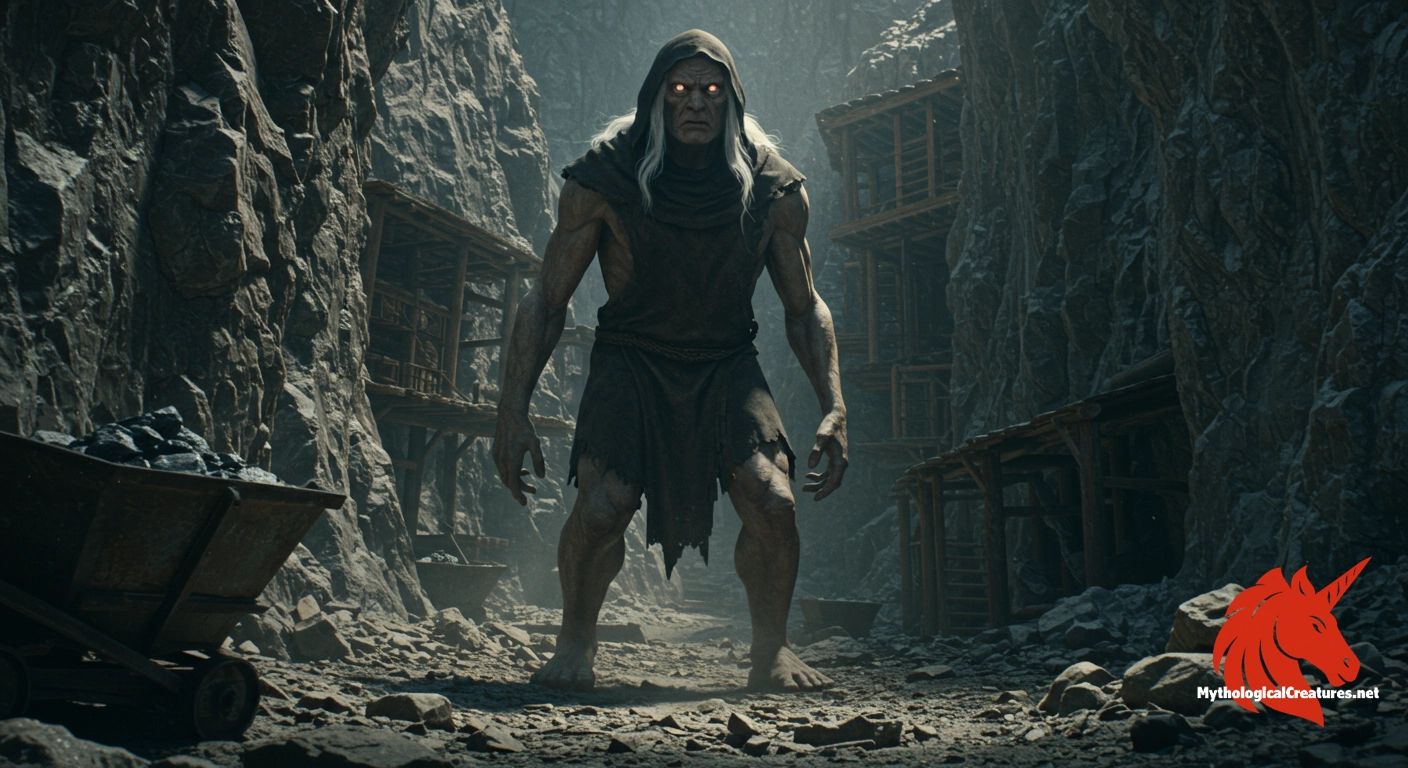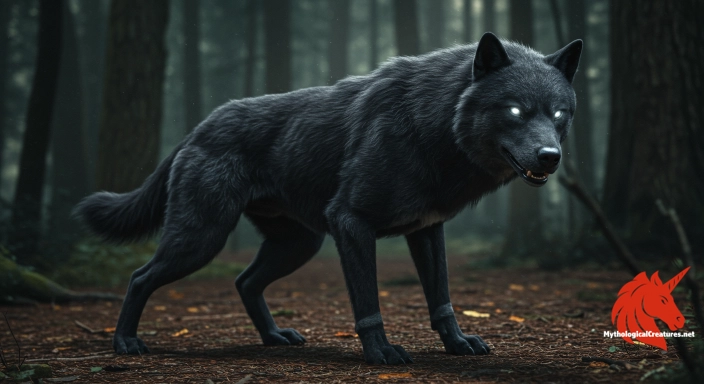Bergmönch: The Bergmönch is a formidable mountain spirit from German folklore, renowned for his giant size and fierce demeanor.

Bergmönch
Bergmönch - Embodies the dual nature of protection and retribution in mining communities, enforcing a strict moral code among miners
Origins & First Encounters
The Bergmönch emerges from the rugged landscapes of German folklore as a mountain spirit whose lore intertwines both ominous and protective qualities. His dual identity as a solemn, monk-like figure and as the industrious miner known as Meister Hämmmerling sets him apart in the mythic tradition. Rooted in the harsh environment of mountain mines and ancient pits, his legend reflects a time when natural forces and human endeavour were deeply interlinked. Early oral traditions, later passed into written folklore, recount his deeds with a mixture of reverence and trepidation. His tale is woven into the cultural fabric of mining communities, where every echo in the dark tunnels and every rumble from the depths could be a sign of his presence. The spirit’s origin, though shrouded in mystery, is emblematic of the ever-changing boundary between the material world and the unseen. Each retelling of his myth has served as both a cautionary tale and an explanatory myth for the capricious nature of the mountains. By embodying the precarious balance between benevolence and wrath, the Bergmönch has captivated imaginations for generations.
Source Texts & Tale Variants
The stories of the Bergmönch have reached us through a rich tapestry of oral and written sources, each adding layers to his multifaceted persona. Local mining communities in Germany preserved his legends through generations of storytellers and folk singers, ensuring that his reputation as both a benefactor and a formidable force endured. Some accounts portray him as a relentless overseer of the pits, while others highlight his moments of kindness toward diligent miners. Manuscripts and folklore compilations from the late medieval period occasionally mention his name, although his true origins remain diffuse and imprecise. Variations of his tale are scattered across different regions, where his character adapts to the local ethos and mining traditions. In some texts, he is introduced under the title of Meister Hämmmerling, linking him directly to the labour and hardships of the mining world. His myth has been passed down in families, making its way into local festivals and regional storytelling traditions. Despite the fragmentary nature of the surviving sources, the recurring themes of retribution, guidance, and the raw power of nature are unmistakably central to his narrative.
Form & Powers
Visually, the Bergmönch is depicted as an immense, imposing figure whose physical presence dwarfs ordinary men. His white hair and eyes, said to burn with a fiery intensity comparable to dining plates, grant him an almost otherworldly countenance. Frequently, he is portrayed wearing a black hooded cowl reminiscent of a monk’s attire, a detail that not only inspires his name but also lends an air of austere mystery. In some depictions, he is clad in the rugged garb of a miner, complete with practical accessories that symbolise his connection to the subterranean world. This duality in his appearance speaks to his composite nature as both a spiritual guardian and a labourer of the depths. Beyond his human form, the Bergmönch is also believed to be capable of shape-shifting, transforming into a long-necked, formidable horse with equally terrible eyes. Such metamorphic abilities underscore his control over the physical realm, even as they enhance his mythic unpredictability. The dramatic interplay of light and shadow in his descriptions serves to amplify the sense of awe and trepidation he instils in those who encounter him.
Regional Faces
Across various German-speaking regions, the Bergmönch’s myth undergoes subtle transformations that reflect local cultural and environmental influences. In the mountainous mining areas of the Alps and the Harz, his image is particularly potent, embodying the fierce spirit of nature as well as the discipline inherent in the mining profession. Some locales accentuate his role as a vigilant guardian who rewards industry and punishes vice, while others focus on his volatile temper and destructive potential. Local adaptations often recast him as a symbol of the unpredictable forces that miners must respect, blending the line between helpful supernatural intervention and perilous retribution. In several communities, his dual iconography—monastic and miner—is deliberately emphasised to mirror the complexities of life in the mountains. These regional variants not only preserve the core elements of his myth but also imbue him with characteristics unique to the local folklore. By adapting his story to the nuances of their environment, different communities have kept his legend alive and relevant. This regional adaptation highlights how a single mythical figure can evolve to represent distinct aspects of cultural identity and environmental respect.
Cultural Parallels
When compared to other mythological beings, the Bergmönch stands as a unique synthesis of power, creativity, and retribution. Similar to earth spirits and mountain guardians found in Norse and Celtic traditions, his character serves as a bridge between the human and natural worlds. While creatures such as trolls and dwarfs also inhabit the realms of rock and mineral wealth, the Bergmönch is distinguished by his explicit moral dimension, rewarding industriousness and punishing wrongdoing. His dual ability to aid and to harm evokes comparisons with other folklore figures whose roles oscillate between beneficence and vengefulness. The capacity for shape-shifting, particularly his transformation into a horse, draws parallels with changelings and other mutable entities present in European myth. Unlike many purely malevolent spirits, however, his actions are framed within a strict ethical context, where justice and retribution go hand in hand with assistance and protection. The interplay of elemental fire in his eyes and the symbolic potency of his presence resonate with similar motifs in Mediterranean and Slavic mythologies. By embodying the temperamental yet instructive side of nature, his narrative aligns with a broader tradition of spirits that serve as moral custodians of their environments.
Legacy & Modern Evolution
Over the centuries, the legend of the Bergmönch has evolved, mirroring the shifts in social, cultural, and industrial landscapes. In earlier times, his portrayal as both a fearsome enforcer and a beneficent guide resonated deeply with communities that depended on the treacherous yet lucrative art of mining. As industrial advancements transformed mining practices, the Bergmönch came to represent a nostalgic connection to the mystical forces believed to govern the natural world. Modern reinterpretations cast him not merely as a relic of the past but as a multifaceted symbol of nature’s enduring power and the struggle between human endeavour and the unpredictable environment. Contemporary literature and art often draw upon his imagery to evoke themes of resilience, retribution, and the enigmatic allure of the mountains. Festivals and local heritage events in some rural communities have even embraced his myth, celebrating the blend of danger and wisdom he embodies. His tale has found a place in modern fantasy narratives, where ancient spirits are rediscovered and reimagined. Consequently, the legacy of the Bergmönch continues to inspire awe, prompting both reflection on humanity’s relationship with nature and appreciation for the depth of traditional folklore.
Interesting Fact
An intriguing aspect of the Bergmönch is the conditional nature of his blessings, where miners must sacrifice some of their tools in exchange for discovering hidden mineral lodes, symbolising a deep cultural intertwining of labour, risk, and reward.
Quick Creature Info
Origin:
Associations:
Our Mythic Legendary Rating:

Also Sometimes Known As:
Habitat:
Supernatural Powers:
Physical Attributes:
Abilities:
Behavior:
Weaknesses:
Lore:
References
Discover Another Mythical Legend You May Not Have Heard Of?
Uncover the mysteries of ancient folklore and expand your knowledge of legendary beings from cultures around the world.
Dare to Meet the Inugami....
Curated by the Mythological Creatures Team (rev. May 2025)
